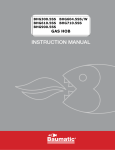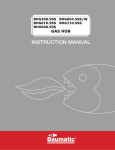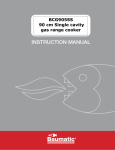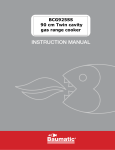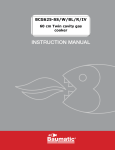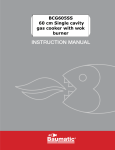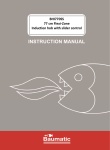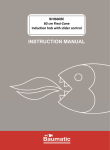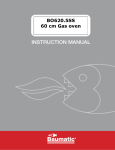Download Baumatic BHI909TS. GWK User manual
Transcript
BHI909TS.GWK 90cm Induction & Gas Hob 1 User Manual for your Baumatic BHI909TS.GWK 90 cm Induction & Gas Hob NOTE: This User Instruction Manual contains important information, including safety & installation points, which will enable you to get the most out of your appliance. Please keep it in a safe place so that it is easily available for future reference; for you or any person not familiar with the operation of the appliance. JW 17/05/13 2 Contents Environmental note Important safety information 4 5–8 Specifications Product specifications Standard accessories Gas & Electrical details Hob surface layout Control panel layout 9 – 11 9 10 10 11 12 Using the induction hob Before first use Touch controls Switching the hob on Switching on a zone and setting a power level Power levels The boost function Switching off a zone Switching the hob off Residual heat indicator Pan sensor Cookware that is suitable for an induction hob The hob timer (minute minder) The hob timer (linked to a cooking zone) Locking the hob top Safety cut-off High temperature protection Hob guidelines 12 - 22 12 13 13 14 15 15 16 16 16 17 17 18 19-20 20 21 21 21 - 22 Using the gas hob Switching the hob on Automatic ignition with flame failure device Energy saving tips 23 - 25 23 24 25 Cleaning and maintenance Cleaning the induction hob top After each use Cleaning table Using a induction hob scraper Using a specialist induction hob cleaner Cleaning the gas hob burner Maintaining the cast iron pan stand 26 - 28 26 26 26 27 27 27 28 Installation Positioning Unpacking the appliance Installing the appliance Electrical connection Connecting the mains supply cable Replacing the mains supply cable Gas connection Ventilation requirements Gas Safety (Installation and Use) Regulations Gas Adjustment (Conversion to LPG) Minimum flow adjustment for hob gas taps Gas tap maintenance 29 - 40 29-31 31 31-32 33-34 34 34 35 35-36 37 38 39 40 My appliance isn’t working correctly Error codes Baumatic consumables 41 - 43 42 44 Contact details 47 3 Environmental note o The packaging materials that Baumatic uses are environmentally friendly and can be recycled. o Please discard all packaging material with due regard for the environment. 4 Important safety information Your safety is of the utmost importance to Baumatic. Please make sure that you read this instruction booklet before attempting to install or use the appliance. If you are unsure of any of the information contained in this booklet, please contact Baumatic Customer Care. General Information o This appliance is designed for domestic household use and for the cooking and frying of domestic foodstuffs. o IMPORTANT: The adjacent furniture and all materials used in the installation must be able to withstand a minimum temperature of 85°C above the ambient temperature of the room it is located in, whilst in use. o Certain types of vinyl or laminate kitchen furniture are particularly prone to heat damage or discolouration at temperatures below the guidelines given above. o Any damage caused by the appliance being installed in contravention of this temperature limit, will be the liability of the owner. o Your new appliance is guaranteed against electrical or mechanical defects, subject to certain exclusions that are noted in Baumatic’s Conditions Of Guarantee. The foregoing does not affect your statutory rights. o The use of this appliance for any other purpose or in any other environment without the express agreement of Baumatic Ltd. will invalidate any warranty or liability claim. o You should not use this appliance to store items on or as a work surface. o No modifications to the appliance are permitted by Baumatic Ltd. o You should not store or place flammable or highly flammable liquids/materials on top of or near the appliance. Items made from aluminium, plastic or plastic film should also be kept away from the appliance, as they may fuse to the surface. o Repairs may only be carried out by Baumatic service engineers or their authorised service agent. 5 Child Safety o Baumatic strongly recommend that babies and young children are prevented from being near to the appliance and not allowed to touch the appliance at any time. During and after use, all surfaces will be hot. o If it is necessary for younger family members to be in the kitchen, please ensure that they are kept under close supervision at all times. o Older children should only be allowed to utilise the appliance when supervised. General Safety o The appliance should only be installed and connected by a suitably qualified person. o Care should be taken to ensure that the units and work surfaces that you build the appliance into, meet with the relevant standards. o The appliance should only be installed and connected by a GASSAFE registered installer. o If you notice any scratches, splits or cracks in the induction glass, you should immediately switch off the appliance and disconnect it from your mains supply. Otherwise there is the risk of electric shock occurring. o CAUTION: This appliance will become hot during use and retain heat after use. During use o Any film or stickers that are present on the hob surface when it is delivered should be removed before use. o Care should be taken when utilising the appliance, otherwise there is a risk of burns being caused. o You should not allow the electrical connection cables to come into contact with the hob surface when it is hot or any hot cookware. o If fat and oil overheats, then it can ignite extremely quickly. For this reason, when cooking with fat and oil the appliance should not be left unattended. o Make sure that all of the cooking zones are switched off after use. 6 Cleaning o Cleaning of the hob should be carried out on a regular basis. o IMPORTANT: Before attempting to clean the appliance, it should be disconnected from the mains and allowed to cool. o Great care should be taken whilst using this appliance and when following the cleaning procedure. o You should not use a steam jet or any other high pressure cleaning equipment to clean the appliance. Installation This appliance must be correctly installed by a GASSAFE registered installer, strictly in accordance with the manufacturer’s instructions. Please see the specific section of this booklet that refers to installation. o Baumatic Ltd. declines any responsibility for injury or damage, to person or property, as a result of improper use or incorrect installation of this appliance. o If the appliance is being used in a Leisure Accommodation Vehicle, the requirements of N 721 MUST be followed. o Baumatic Ltd DOES NOT recommend that this appliance is installed on any type of marine vessel. Declaration of conformity This appliance complies with the following European Directives: -2006/95/CE General regulations / Low tension -1935/2004/CE 90/128/EEC This appliance is suitable to come in contact with food -2004/108/CE Electromagnetic compatibility o The manufacturer declares that the hob is built using certified materials and requires the appliance to be installed in accordance with the standards currently in force. This appliance must be used by a trained person for domestic purposes only. 7 o IMPORTANT: The induction hob fully complies with current legislation regarding electro-magnetic interference and is designed not to interfere with other electronic appliances providing these comply with the same legislation. o As the induction hob generates magnetic fields in its immediate vicinity, pacemakers and active heart implants must be designed to comply with relevant regulations. If in doubt, you should consult the manufacturer of your device or your doctor. In this respect, Baumatic can only guarantee the conformity of our own product. o If an object made of metal, (e.g. saucepan lid, knife, fork or spoon) is placed on a cooking zone that is switched on, it can get hot. To avoid damaging your appliance o The induction glass can be damaged by objects falling onto it. o The induction glass edge can be damaged by knocks from cookware. o Cast iron and cast aluminium cookware with damaged bases may scratch the induction surface if they are dragged across it. o Pans should be lifted on and off the hob surface and not dragged. o Cooking zones should not be switched on without cookware placed on it. Also the cookware should not be empty. o Food or liquid that has high sugar content may damage the hob top, if it comes into contact with the induction hob surface. Any spillages should be wiped up immediately, however this may not prevent the hob surface from becoming damaged. 8 Specifications Product dimensions: Aperture dimensions: Depth: Width: Height: Depth: Width: Height: 510 mm 900 mm 55 mm 490 mm 880 mm 20 mm (min) Product specifications: 1 1 1 1 x x x x 3.00 2.30 1.40 1.40 kW kW kW kW induction induction induction induction zone zone zone zone (Ø 210 mm) with booster (3.00 kW) (Ø 210 mm) with booster (1.85 kW) (Ø 160 mm) (Ø 160 mm) o o o o o o o Front touch control operation Safety lock 4 individual residual heat indicators 4 independent induction generators Electronic timer Pan compatibility detection Bevelled edges 1 x 4.00 kW triple crown (wok) burner o o o o Front control operation Heavy duty cast iron pan stand Automatic ignition Flame failure safety device on wok burner 9 Standard accessories o Induction hob scraper o LPG conversion jets Electrical details Rated Voltage: Supply Connection: Max Rated Inputs: Mains Supply Lead: 220 - 240 Vac 50 / 60 Hz 40A (double pole switched fused outlet with 3mm contact gap) 7.40 kW 3 core x 6 mm² (not supplied) Gas details Connection: Type: Rp ½ (ISO R7) Natural Gas (20 mbar) Alternative LPG G30 (28-30/37 mbar) For future reference please record the following information which can be found on the rating plate and the date of purchase which can be found on your sales invoice. The rating plate of your hob is located on the underneath of the appliance. Therefore it is a good idea to record this information before you install your appliance. Model Number ………………………………. Serial Number ………………………………. Date of Purchase ………………………………. 10 Hob surface layout A) 3.00 kW induction zone (Ø 210 mm) B) 1.40 kW induction zone (Ø 160 mm) (booster = 1.85 kW) C) 2.30 kW induction zone (Ø 210 mm) (booster = 3.00kW) D) 1.40 kW induction zone (Ø 160 mm) E) Induction zone control panel F) 4.00 kW triple crown gas burner G) Gas wok zone control knob 11 Control panel layout Induction hob 1) ON / OFF button 2) Plus button(s) / cooking zone selection button(s) 3) Minus button 4) – 5) Timer button 6) Zone temperature / status display(s) 7) Timer display 8) – 9) Timer indicator LED 10) – 11) Booster button Gas Hob F1) Single (inner) flame F2) Duel flame Using the induction hob Before first use IMPORTANT: You should clean the induction hob surface (see “Cleaning and maintenance” section). o You should switch on one induction cooking zone at a time for 5 minutes at the maximum setting. This will help to eliminate any new smell that exists and evaporate any humidity that has formed on the heating elements during transit. o Do not burn off more than one zone at once. o You must place a saucepan filled half full with cold water on each zone as you burn it off. Otherwise the induction zone will not operate. 12 Touch controls o All operations are performed by means of the touch controls that can be found on the control panel. o The controls respond to touch so you do not need to add any pressure. o You should use the ball of your finger not the tip when using the controls. o A beep will sound each time a touch is registered. o You should ensure that the controls are kept clean, dry and that no objects such as utensils or cloths cover them. Even a thin film of water may make the controls difficult to operate. Switching the hob on o When the hob is connected to a power supply the control panel will initialise for about 3 seconds. The LED lights will illuminate and the controls will not be operational during this time. Once the initialisation has completed the hob will go into stand-by mode. o To turn the hob on you should press the ON/OFF button. o NOTE: Only the ON/OFF button can be pressed when turning the hob on. If the hob detects any other key activation it will remain in stand-by mode. o All of the cooking zone indicators will show “0” and the dot in the bottom corner of each cooking zone selector (2) will flash to indicate that no zone has been selected. 13 Switching on a zone and setting a power level IMPORTANT: A zone must be selected within 20 seconds of turning the hob on. After this time the hob will return to stand-by mode. o Make sure that the bottom of the pan and the surface of the hob are clean and dry before placing a suitable pan on the cooking zone that you wish to use. o Press the cooking zone selection button (2) of the cooking zone that you want to use. o Select the power level for the cooking zone that you have selected using the plus button of the zone you are using and the minus button. If you do not choose a heat setting within 20 seconds of turning the hob on, the hob will switch off automatically. o You can alter the power level at any time during cooking using the plus and minus buttons. o If the display flashes with the symbol shown opposite, alternatively with the heat setting, this means that: You have not placed a pan on the correct cooking zone or, The pan you are using is not suitable for induction cooking or, The pan is too small or not properly centred on the cooking zone. o No heating will take place unless there is a suitable pan on the cooking zone. The display will automatically turn off after 20 seconds if no suitable pan is placed on it. 14 Power levels o For a general guide to cooking various foods at the different power levels please refer to the table below. o Please note that this table should be viewed as a guide only and that other factors such as cookware, weight and amount of food and personal preference will all influence the power level required. Power Level 1-2 3-4 5-6 7-8 9 Recommended Use o Delicate warming of small amounts of food. o Melting chocolate, butter and foods that burn quickly. o Gentle simmering. o Slow warming. o Reheating. o Rapid simmering. o Cooking rice. o Cooking pancakes. o Sautéing. o Cooking pasta. o Stir-frying. o Searing. o Bringing soup to the boil. o Boiling water. The boost function To obtain a faster and more powerful heating speed, the power booster function can be used for the top cooking zones. o Press the zone selection button of one of the top zones (B) or (C). o Then press the booster button. The cooking zone indicator will show “P” to indicate that the function has been activated. The boost function will operate the zone at maximum power for 10 minutes. After this time, the cooking zone will return to its original power setting. The booster function can only be used on the back cooking zones (Zone B = 1.40 kW induction zone + booster = 1.80 kW. Zone C = 2.30 kW induction zone + booster = 3.00kW). o The booster function can be de-activated by selecting the relevant zone and then pressing either the booster button again, or by selecting a new temperature from 1 – 9 on the control panel by using the minus button. 15 Switching off a zone o Press the cooking zone selection button of the cooking zone that you want to switch off. o Press and hold down the minus button until the number in the cooking zone indicator reaches “0”. Alternatively you can press the plus and minus buttons simultaneously to reset the zone to “0”. o After a few seconds, the cooking zone will switch off. o A “H” and “0” symbol will flash alternatively in the cooking zone indicator until the surface has cooled down to a safe temperature (see the section on the “residual heat indicator” for further information). Switching the hob off Once you have switched off all of the cooking zones, you should switch the hob off. o Press the ON/OFF button. o It is possible to turn the hob off at any time by pressing the ON/OFF button. Residual heat indicator o After a zone is switched off, the corresponding cooking zone indicator will show a letter “H” (HOT) and “0” (OFF) flashing alternatively. This means that the temperature of the zone is over 60°C and is therefore still high enough to cause injury. o IMPORTANT: The residual heat indicator will disappear if your mains supply is cut. Care should be taken in case the surface temperature is still high. 16 Pan sensor Each zone has a sensor on it, so it can detect the presence of a pan. o The sensor is fine-tuned to detect a pan being placed on it. The pan should be one size smaller than the nominal diameter of the zone. o If after placing a pan on a cooking zone and selecting that cooking zone, a “U” shaped symbol appears on the cooking zone indicator, this means that the pan is either the incorrect size or shape. Or it could be made from a material that is inappropriate for use on an induction zone hob. o If a cooking zone is selected but no pan is detected, the pan sensor system will check for the presence of a pan approximately every few seconds. If no pan is detected after 2.5 seconds the hob will automatically switch off o You should check that your pans are suitable for use on an induction zone hob (see the pan manufacturer’s trademark or instructions). Cookware that is suitable for an induction hob The table below shows cookware that is normally suitable for use on an induction zone hob:Cookware Steel, enamelled steel Cast iron Stainless steel Aluminium, copper, brass Glass, induction, porcelain Suitable Yes Yes Yes (if stated manufacturer) No No by the pan o The bottom of the pans should be as flat and thick as possible. o Certain types of cookware may result in a noise being made when being used on an induction zone hob. This does not mean that there is an appliance fault. o IMPORTANT: You should make sure that all pans are placed in the centre of the induction zone that you are using. 17 The hob timer (minute minder) Your hob has a timer which will countdown a period of time between 1 and 99 minutes. At the end of the countdown period an audible signal will sound. No induction zone can be in use while using the minute minder. o Press the ON/OFF button to turn the hob on. o Press the timer button to enter the minute minder setting mode. The timer indicator will flash and the default countdown time of “00” minutes will appear in the display. o Set the required countdown time using the plus and minus buttons. Each press of the plus or minus button will increase or decrease the time by 1 minute. o If you press and hold the plus or minus button the time will increase or decrease at a faster rate. o When the required countdown time is shown in the display (7), release all buttons. The display will show the remaining time and the timer indicator will flash for a few seconds before the countdown begins automatically. o When the set countdown time has elapsed an alarm will sound for 2 minutes or until any button is pressed. The timer indicator will show “00”. o You can cancel the minute minder at any time by pressing the plus and minus buttons simultaneously. The timer display will show “00” and the minute minder will be cancelled. o You can modify the countdown timer any time by using the plus/minus keys. o You can also cancel the minute minder by adjusting the countdown timer down to “00”, or by pressing the power button twice. 18 The hob timer (linked to a cooking zone) You are able to link a countdown time to a cooking zone so that when the countdown time has elapsed the cooking zone will switch off automatically. o Press the ON/OFF button to turn the hob on. o Press the cooking zone selection button of the cooking zone that you want to use and place a suitable pan on the selected cooking zone. o Select the power level for the cooking zone that you have selected, using the plus and minus buttons o Press the timer button to enter the countdown setting mode. The timer indicator will flash and the default countdown time of “00” minutes will appear in the display. o Set the required countdown time using the plus and minus buttons. Each press of the plus or minus button will increase or decrease the time by 1 minute. o If you press and hold the plus or minus button the time will increase or decrease by 10 minutes. o When the required countdown time is shown in the display, release all buttons. The display will show the remaining time and the timer indicator will flash for a few seconds before the countdown begins automatically. o A red dot (LED) will appear in the corner of the timer display (7) to indicate the relevant zone associated with the hob timer. E.g. If the bottom right LED is on, the bottom right cooking zone has an operational timer. NOTE: You can set up a hob timer for each induction cooking zone separately, which can run simultaneously. Just follow the steps above, using the hob selection buttons (2) to select each hob independently. Once set, the timer (7) will display the time/hob ending the soonest. WARNING: If any other cooking zones are in use without the hob timer they will continue heating. You will need to switch them off manually when cooking is complete. o When the set hob time has elapsed an alarm will sound for 2 minutes or until any button is pressed, and the cooking zone will turn off. The timer indicator will show “00”. 19 o You can cancel the hob timer at any time by selecting the relevant zone using the selection button (2) and then pressing the plus and minus buttons simultaneously. The timer display will show “00” and the minute minder will be cancelled. o You can modify the hob timer any time by selecting the relevant zone and using the plus/minus keys. o You can also cancel the hob timer by selecting the relevant zone and adjusting the countdown timer down to “00” using the plus/minus buttons, or by pressing the power button twice. Locking the hob top It is possible to lock the controls to prevent unauthorised usage of the controls by other persons such as children. o The whole hob top can be locked by pressing the front right cooking zone selection button and the minus button simultaneously. o Immediately after, press the front right cooking zone selection button only. o The timer display will show “L” to indicate that the safety lock feature has been switched on. IMPORTANT: The above operation must be completed within 10 seconds, and no other buttons can be pressed, or the hob will not lock. NOTE: If a zone is in the ‘hot’ condition, the display will flash “L” and “H” alternatively, until the zone has cooled. o When the safety lock feature is activated, it will disable all buttons on the control panel apart from the ON/OFF button. o To disable the safety lock feature, you should press front right cooking zone selection button and the minus button simultaneously. o The “L” symbol will disappear from the timer display and you are then able to use the hob in normal operation. Note: If the hob is switched off using the ON/OFF button while the safety lock is activated, the safety lock will still be activated when the hob is turned back on. 20 Safety cut-off o If one or more of the cooking zones are accidentally left on, a safety cut off will activate after a certain period of time. The length of time depends on the power level that a zone or zones have been set on. LEVEL TIME LIMIT (hours) 1–3 8 4–6 4 7–9 2 o If more than one zone is operating when one of the zones reaches its safety cut-off point, only the zone which has reached its safety cut off point will switch off. High temperature protection o The hob is equipped with a temperature sensor which monitors the temperature inside of the appliance. o If an unusually high temperature is detected the induction hob will stop operating automatically. Induction Hob guidelines o The first few times the hob top is used, it may give off an acrid, burning smell. This smell will disappear completely with repeated use. o The worktop is fitted with cooking areas of different diametre and power. o The positions where the heat will radiate from are clearly marked on the hob top. The saucepans must be positioned exactly on these zones for efficient heating to occur. Pans should have the same diametre as the cooking zone that they are being used on. o You should not use saucepans with rough bottoms, as this can scratch the induction surface. o Before use, make sure that the bottoms of the saucepans are clean and dry. o When cold, the bottom of the pans should be slightly concave, as they expand when hot and lie flat on the surface of the hob. This will allow the heat to transfer more easily. 21 o The best thickness for the bottom of the pans is 2 – 3 mm of enamelled steel and 4 – 6 mm for stainless steel with sandwich type bottoms. o If these rules are not followed, then there will be a great loss of heat and energy. Heat not absorbed by the saucepan, will spread to the hob, frame and surrounding cabinets. o Preferably cover pans with a lid to permit cooking at a lower heat. o Always cook vegetables and potatoes, etc. in as little water as possible to reduce cooking times. o Food or liquid that has high sugar content may damage the hob top if it comes into contact with the induction hob surface. Any spillages should be wiped up immediately, however this may not prevent the hob surface from becoming damaged. o IMPORTANT: The induction hob surface is tough; however it is not unbreakable and can be damaged. Especially if pointed or hard objects are allowed to fall on it with some force. o DO NOT USE THE HOB IF THE SURFACE BECOMES BROKEN OR CRACKED. YOU SHOULD CONTACT THE BAUMATIC CUSTOMER CARE DEPARTMENT IMMEDIATELY. 22 Using the gas hob Switching on the burner IMPORTANT: You should clean the hob surface (see “Cleaning and maintenance” section). The following symbols will appear on the control panel, next to the control knob: Circle: gas off Turn the knob right to ignite and use the single/inner burner (F1). Turn the knob left to ignite and use the triple flame burner (F2). Star: maximum setting / ignition position o The minimum setting is at the end of the rotation of the control knob (towards the bottom). o All operation positions must be selected between the maximum and minimum position, as indicated on the control knob. o Never select a knob position between the maximum (ignition) and off position. 23 Automatic ignition with flame failure safety device The wok burner is fitted with a flame failure safety device, which is designed to stop the flow of gas to the burner head in the event of the flame going out. To ignite a burner: o Press in the control knob of the burner and turn it to the ignition position. o If you keep the control knob depressed, the automatic ignition for the burner will operate. o You should hold down the control knob for 20 seconds after the flame on the burner has lit. o After this 20 second interval, to regulate the flame you should continue turning the control knob until the flame is at a suitable level. The operating position MUST be at a position between the maximum and minimum position. o To switch the burner off, turn the control knob fully to the gas off position. o In case of power failure, the burner can be lit by carefully using a match. 24 Energy saving tips Burner Wok Pan size Ø min Ø max 200 mm 320 mm o The diameter of the bottom of the pan should correspond to that of the burner. o The burner flame must never extend beyond the diameter of the pan. o Use flat bottomed pans only. o When possible, keep a lid on the pan whilst cooking. o Cook vegetables with as little water as possible, to reduce cooking times. IMPORTANT: Always place pans centrally over the hob burner and position them so that the handles cannot get accidentally caught or knocked off. You should also make sure that the handle is not over one of the other hob burner flames. 25 Cleaning and maintenance Cleaning operations must only be carried out when the hob is cool. The appliance should be disconnected from your mains supply before commencing any cleaning process. Cleaning the induction hob top Any residues that are left on the hob top surface from cleaning agents will damage it. You should remove any residues with warm water and a little washing up liquid. Abrasive cleaners or sharp objects will damage the hob surface; you should clean it using warm water and a little washing up liquid. Although it is easier to clean some deposits whilst the hob surface is still warm, you should take care not to burn yourself if cleaning the hob surface when it is still warm. After each use o Wipe the appliance over with a damp cloth and a little washing up liquid. o Dry the appliance by rubbing the surface with a clean cloth. Cleaning table Type of deposit Remove Remove immediately? when the appliance has cooled down? Yes No What should I use to remove the deposit? Yes No Fat splashes No Yes Metallic discolourations Water splashes or water rings No Yes No Yes Induction scraper Induction cleaner Induction cleaner Induction cleaner Sugar or food/liquid containing sugar Tin foil or plastic 26 Induction hob scraper hob hob hob hob Using a induction hob scraper A induction hob scraper will be provided with your appliance. The following guidelines should be followed when using the induction hob scraper:- o The scraper should be placed on the induction surface at an angle. o Residues should be removed by sliding the blade carefully over the induction surface. o The induction surface should be wiped with a damp cloth and a small amount of washing up liquid. o Dry the appliance by rubbing the surface with a clean cloth. Using a specialist induction hob cleaner It is possible to purchase specialist induction hob cleaner/conditioner. You should follow the instructions given by the manufacturer of the specialist induction hob cleaner. You should ensure that it is suitable for use on your appliance. Cleaning the hob burner The hob burner should be cleaned once a week or more frequently if they get soiled. o IMPORTANT: Make sure that the hob surface, pan stand and hob burner have cooled before you attempt to touch them. o Remove the hob burner by pulling them upwards and away from the hob top. o Soak them for about ten minutes in hot water and a little detergent. o After cleaning and washing them, wipe and dry them carefully. o Before placing the burner back on the hob top, make sure that the gas jet is not blocked. o IMPORTANT: Make sure that you reassemble the burner in the original way. 27 Maintaining the cast iron pan stands o IMPORTANT: Make sure that the hob surface and pan stands have cooled before you attempt to touch them. o Wipe the pan stands over with a soft, damp cloth that has been put into warm soapy water. The cloth should be wrung out after being taken out of the soapy water. o Using a paper towel, thoroughly dry the pan stands. o To maintain the appearance of the cast iron pan stands, we would recommend that you rub a small amount of olive oil into the pan stands, after you have finished cleaning them. 28 Installation The installation must be carried out by a suitably qualified person, in accordance with the current version of the following. o UK Regulations and Safety Standards or their European Norm Replacements. o Building Regulations (issued by the Department of the Environment). o Building Standards (issued by the Scottish Development Department). o IEE Wiring Regulations. o Electricity At Work Regulations. Positioning The adjacent furniture must be able to withstand a minimum temperature rise of 85°C above the ambient temperature of the room it is located in, during periods of use. * 900 mm o This appliance can be located in a kitchen, a kitchen diner or a sitting room. IMPORTANT: The appliance must not be installed in a bathroom or shower room. 29 This appliance is classified as Class 3 and therefore is to be built into a kitchen unit (depending on size) or 600 mm worktop that is between 30 mm and 40 mm thick. The following minimum clearance distances must be observed:o The rear edge of the hob must be a minimum distance of 50 mm from the rear wall. o If the hob is positioned so that the right or left hand side of the appliance will be near to the edge of a kitchen unit. There must be a gap of at least 100 mm between the side of the hob and the vertical surface of any kitchen unit that is made of a combustible material. If the vertical surface is made of a non-combustible material, then 50 mm clearance is sufficient. HOWEVER sufficient space must be allowed for saucepan handles to be turned and for saucepans to be used safely. o 900 mm between the highest point of the hob surface (including the burner) and the underside of any horizontal surface directly above it. o 400 mm between the hob surface, providing that the underside of the horizontal surface is in line with the outer edges of the hob. If the underside of the horizontal surface is lower than 400 mm, then it must be at least 50 mm away from the outer edges of the hob. o 50 mm clearance around the appliance and between the hob surface and any combustible materials. o IMPORTANT: Underneath the appliance there must be a partition made of insulating material (e.g. wood). There must be a gap of at least 20 mm between the underneath of the appliance and this partition. 30 o You must make sure that there is a 5 mm gap below the underneath of the worktop at the front edge of the hob. Unpacking the appliance When unpacking the appliance please check that the following items are contained within the packaging: 1 x Baumatic hob Pan stand Burner assemblies Instruction manual Warranty card Fixing screws Clamps Sealing strip LPG conversion jets Self-adhesive label for amending the gas category on the appliance’s rating plate (required if the LPG conversion jets are used). Installing the appliance o Cut a hole in the worktop that corresponds with the drawing shown above. o Remove the protective covering from the sealing strip 31 o Apply the sealing strip provided around the edge of the appliance. o Do not leave a gap in the sealing strip or overlap the thickness. IMPORTANT: Do not use a silicon sealant to seal the appliance against the aperture. This will make it difficult to remove the hob from the aperture in future, particularly if it needs to be serviced. o Carefully turn the hob back over and then gently lower it into the aperture hole that you have cut out. o On the underneath of the hob, place the clamp(s) (B) into position on in each corner of the hob. o Adjust the clamps into a position that is suitable for your worktop, as shown in the diagrams on the left. o Slightly tighten the screw (C) through each clamp (B) so that the clamp is attached to the hob. o Once you are satisfied of the position of the hob, you can fully tighten the screws (C) to secure the hob into position. 32 Electrical connection This appliance must be installed by a qualified person in accordance with the latest edition of the I.E.E. Regulations and in compliance with Baumatic’s instructions. Before connecting the appliance, make sure that the supply voltage marked on the rating plate corresponds with your mains supply voltage. WARNING: THIS APPLIANCE MUST BE EARTHED. o This appliance must be wired into a 40A double pole switched fused spur outlet, having 3 mm contact separation and placed in an easily accessible position adjacent to the appliance. It should not be located above the appliance and no more than 1.25m away from it. o The spur outlet must still be accessible even when your hob is located in its operating position. o Cable type: H05 V2V2 – F3 x 2.5², or F4 x 2.5 mm² Connecting the mains supply cable o The mains terminal block is located on the underside of the hob and the terminals are accessible by removing the terminal block cover by removing the cover screw. IMPORTANT: The power cable is not supplied with the appliance. 33 o The brass links must be positioned as shown in the diagram above and once established ALL terminal screws must be tightened down firmly. o You should use a good quality screwdriver to carefully, fully tighten ALL of the terminal screws. o If when the hob is first switched on, only two of the zones work, you should recheck that the terminal screws are all fully tightened. This should be done before contacting the Customer Care Department. o IMPORTANT: The appliance must NOT be connected to the mains supply by means of a 13A plug and socket. o The cable can be looped if necessary, but make sure that is not kinked or trapped when the hob is in position. Care must be taken to avoid the cable being in contact with hot parts of the appliance. Replacing the mains supply cable If the mains supply cable is damaged, then it must be replaced by an appropriate replacement. The mains supply cable should be replaced in accordance with the following instructions: o Switch the appliance off at the mains supply. o Open the terminal block on the underside of the hob. o Unscrew the terminal screws fixing the cable. o Replace the cable with one of the same length and in accordance with the specification given on page 33. o The “green-yellow” earth wire must be . It connected to the terminal marked must be about 10 mm longer than the live and neutral wires. o The “blue” neutral wire must be connected to the terminal marked with letter (N). o The “brown” live wire must be connected to the terminal marked with letter (L). 34 Gas connection This appliance must be installed by a competent person in accordance with the current versions of the following UK (United Kingdom) or ROI (Republic of Ireland) Regulations and Safety Standards or their European Norm Replacements. Important information o This hob is supplied to run on natural gas only and cannot be used on any other type of gas without modification. o Conversion for use on LPG and other gases must only be undertaken by a qualified person. For information on the use of other gases, please contact the Baumatic Customer Care Department. o The hob must be installed by a qualified person, in accordance with the current edition of the Gas Safety (Installation and Use) (Amendment) Regulations and the relevant building/I.E.E. Regulations. o Failure to install the appliance correctly could invalidate the manufacturer's guarantee and lead to prosecution under the regulations quoted above. o In the UK, GASSAFE registered installers are authorised to undertake the installation and service work, in compliance with the above regulations. Ventilation requirements o The room containing the hob should have an air supply in accordance with the current edition of BS 5440: Part 2: o The room must have opening windows or equivalent; some rooms may also require a permanent vent. o If the room has a volume between 5 and 10m³, it will require an air vent of 50cm² (effective area). Unless it has a door which opens directly to the outside. o If the room has a volume of less than 5m³, it will require an air vent of 100cm² (effective area). o If it is installed in a room with a volume that exceeds 11m³, then no air vent is required. 35 o If there are any other fuel burning appliances in the same room the current edition of BS 5440: Part 2: should be consulted to determine air vent requirements. o Ensure that the room containing the hob is well ventilated, keep natural ventilation holes or install a mechanical ventilation device (mechanical cooker hood). o Prolonged intensive use of the appliance may call for additional ventilation, either by the opening of a window, or by increasing the level of the mechanical ventilation device (where present). o This hob is not fitted with a device for discharging the products of combustion. Ensure that the ventilation rules and regulations are followed. o The walls behind and near the hob should be resistant to heat, steam and condensation. o Remember that the quantity of air necessary for combustion must never be less than 2m³/h for each kW of power (see total power in kW on the appliance rating plate). 36 Gas Safety (Installation and Use) Regulations IMPORTANT: The appliance MUST be connected to the gas supply by use of a ½ BSP Elbow, seal, copper pipe and an isolation tap fitted in an easily accessible position. o It is the law that all gas appliances are installed by competent persons in accordance with the current edition of the Gas Safety Installation and Use Regulations. o It is in your interest and that of safety to ensure compliance with the law. o In the UK, GASSAFE registered installers work to safe standards of practice. The cooker must also be installed in accordance with the current edition of BS 6172. Failure to install the hob correctly could invalidate the warranty, liability claims and lead to prosecution. o Put the gas seal into the elbow. o Fully tighten the elbow and seal onto the gas rail. o The elbow MUST be pointing in a downwards direction. o Gas pressure may be checked on a semi-rapid hob burner. Remove the appropriate injector and attach a test nipple. Light the other burners and observe that the gas pressure complies with the gas standards in force. IMPORTANT: On completion carry out a gas soundness test. 37 Gas adjustment (Conversion to LPG) All work must be registered engineer. carried out by a GASSAFE IMPORTANT: Always isolate the hob from the electricity supply before changing the injectors and/or adjusting the minimum flow of the burners. o Remove the pan-stands, flame spreaders (A). burners and o Unscrew the injector (B) and replace it with the stipulated injector for the new gas supply (see the table on the next page). GAS TYPE PRESSURE BURNER mbar Ø INJECTOR 1/100 mm THERMAL CAPACITY Nominal W CONSUMPTION Natural gas – G20 20 Triplecrown 71A-95B 4000 381 l/h LPG – G30/G31 28-30/37 Triplecrown 80A-143B 4000 291 g/h o Reassemble all the burners carefully; in particular you should make sure that the flame spreader is correctly placed on the burner. o IMPORTANT: The minimum flow adjustment process must be completed before the appliance is next used. 38 Minimum flow adjustment for hob gas taps. All work must be registered engineer. carried out by a GASSAFE IMPORTANT: Always isolate the hob from the electricity supply before changing the injectors and/or adjusting the minimum flow of the burners. o Switch the burner on and set the knob at the minimum position. o Remove the knob from the tap and place a small bladed screwdriver in the adjusting screw located under the knob. o Unscrew the adjusting screw, in order to increase the gas flow or tighten the adjusting screw to decrease the gas flow. o The correct adjustment is obtained when the flame has a length of about 3 – 4 mm. o For butane/propane gas, the adjusting screw must be tightly screwed in. o Refit the control knob. o Make sure that the flame does not go out by quickly turning from maximum flow to minimum flow. If it does then remove the control knob and make further adjustments to the gas flow, testing it again once the adjustment has been made. o Repeat this process for each one of the gas taps. 39 Gas tap maintenance These maintenance operations MUST ONLY be carried out by a GASSAFE registered engineer. IMPORTANT: Before carrying out any maintenance operations, disconnect the appliance from the gas and electricity supplies. If a gas tap becomes stiff to operate, then you should proceed as follows: o Remove the control knobs, pan supports, burners, hob fixing screws and clamps. o Remove the hob from the worktop and remove any underside protective covers. o Disconnect the fixings holding the tap to the fascia panel and separate the assembly. Then clean the cone and seating, with a cloth dampened with solvent. o Lightly smear the cone with high temperature grease, reassemble into position and rotate a few times. o Remove the cone again and remove any excess grease, making sure that the gas ducts are not obstructed with grease. o Carefully reassemble the components and perform a gas soundness test. If it becomes necessary to replace a gas tap, then you should proceed as follows: o Remove the control knobs, pan supports, burners, hob fixing screws and clamps. o Remove the hob from the worktop and remove any underside protective covers. o Disconnect the fixings holding the tap to the fascia panel and separate the assembly. o Disconnect the gas pipe from the gas tap, and then disassemble them from the gas rail by removing the fixing screws. o When fitting a new tap, ensure that a new gasket is used. o Reconnect the gas tap, perform a gas soundness test and then reassemble the hob. 40 My appliance isn’t working correctly Problem The induction hob cannot be turned on. Possible Causes No power to the appliance. Solution o Make sure the hob is o The touch controls are unresponsive. The safety lock is activated. o The touch controls are difficult to operate. There may be a slight film of water over the controls. You may be using the tip of your finger when touching the controls. Pans with rough edges are being used. An unsuitable cleaning product or scourer is being used. o This may be caused by the construction of your pans where layers of different metals vibrate differently. This is caused by the technology of induction cooking. o A cooling fan that is built into your induction hob has come on to prevent the electronics from overheating. It may continue to run even after you have turned the hob off. The induction hob cannot detect the pan because it is not suitable for induction cooking. The induction hob cannot detect the pan because it is too small for the cooking zone or not properly centred on it. Technical fault. o The glass is being scratched. Some pans make crackling or clicking noises. The induction hob makes a low humming noise when used on a high power level. There is a fan noise coming from the induction hob. Pans do not become hot and a “U” symbol appears in the display. The induction hob or a cooking zone has turned itself off unexpectedly. A tone sounds and an error code is displayed (possibly alternating with one or two digits in the timer display). 41 o connected to the power supply correctly and that it is switched on. Check whether there is a power cut in your home or area. Unlock the controls by following the instructions in this manual. Make sure the control panel is clean and dry. Use the ball of your finger when touching the controls. o Only use pans with flat and smooth bases. o Use appropriate cleaning products and the induction hob scraper for cleaning. This is normal for pans and does not indicate a fault. o This is normal but the noise should lessen or disappear when you decrease the power level. This is normal and requires no action. Do not switch the power to the hob off at the supply while the fan is running. o Use pans that are suitable for induction cooking. o Centre the pan and make sure that its base matches the size of the cooking zone. o Refer to the error codes in the next section and if the fault cannot be remedied call the Customer Care Department. The residual heat indicator has not come on after a cooking zone has been switched off. The cooking zone has only been turned on for a short period of time and therefore did not go above 60°C. o No action required but if the cooking zone appears to be hotter than 60°C and the residual heat indicator has not come on, you should call the Customer Care Department. Error codes The following error codes may appear in the timer display if there is a problem with the operation of the hob. Fault ER03 E2 E9 ER21 U400 E5, E6, E9, ER20 ER22 ER36 ER40 ER47 E5 – E6 Possible cause Continuous operation of keys for 10 minutes Temperature sensor failure or abnormal temperature Solutions Water, spillage or cooking utensils on controls. Ensure the control panel is cleaned and free from objects. Electrical fault Poor heat radiation from a cooking zone Check connection cable is fitted properly Turn off appliance and allow it to cool. Check that the pan is of the correct size to be used on a particular zone. If the pan is correctly sized and the error code reappears, contact the Customer Care Department. Turn off appliance and allow it to cool. Check that the pan is of the correct size to be used on a particular zone. If the pan is correctly sized and the error code reappears, contact the Customer Care Department. Abnormal Check whether the power supply is operating voltage from the normally. mains supply Electrical fault Contact the Customer Care Department and report error code. For any error code we would recommend turning the appliance off and disconnecting from the mains supply for 10 minutes. After reconnecting the appliance, if the error code reappears you should disconnect your appliance and contact Customer Services – reporting the error code. 42 IMPORTANT: If your appliance appears not to be operating correctly, then you should disconnect it from your mains supply and then contact Baumatic Customer Care on telephone number (0118) 933 6911. DO NOT ATTEMPT TO REPAIR THE APPLIANCE YOURSELF. Please note that if an engineer is asked to attend whilst the product is under guarantee and finds that the problem is not the result of an appliance fault, then you may be liable for the cost of the call out charge. The appliance must be accessible for the engineer to perform any necessary repair. If your appliance is installed in such a way that an engineer is concerned that damage will be caused to the appliance or your kitchen, then they will not complete a repair. This includes situations where appliances have been tiled in, sealed in with sealant, have wooden obstructions placed in front of the appliance - like plinths, or any installation other than the one specified by Baumatic Ltd. has been completed. Please refer to the conditions of guarantee that appear on the warranty card that you receive with the appliance. IMPORTANT: Baumatic Ltd. operates a policy of continuous improvement and reserves the right to adjust and modify its products without prior notification. 43 Baumatic Consumables o BC001 Degreaser for Dishwashers (200 g) o BC002 Descaler for Washing Machines and Dishwashers (200 g) o BC003 Induction Hob Cleaner (250 ml) o BC004 Oven Cleaner (250 ml) o BC005 Stainless Steel Cleaner and Protector (250 ml) o BC007 E-Cloth – General Purpose Cloth o BC008 Microwave Cover To order a Baumatic consumable product please call 0123 5437 244 and quote the product code. You can also order online from eshop.baumatic.co.uk 44 45 46 United Kingdom Baumatic Ltd., Baumatic Buildings, 6 Bennet Road, Reading, Berkshire RG2 0QX United Kingdom Sales Telephone (0118) 933 6900 Sales Fax (0118) 931 0035 Customer Care Telephone (0118) 933 6911 Customer Care Fax (0118) 986 9124 Spares Telephone (01235) 437244 Advice Line Telephone (0118) 933 6933 E-mail: [email protected] [email protected] [email protected] [email protected] Czech Republic/Slovakia Baumatic s.r.o. Lípová 665/1 460 01 Liberec 4 Czech Republic Panenská 34 811 03 Bratislava - Staré Mesto Slovakia +420 483 577 200 (CZ) +421 255 640 618 (SK) www.baumatic.cz www.baumatic.sk Germany Kundendienst & Ersatzteile Deutschland 0049(0)180-5888975 Oesterreich +43 (0) 820 / 420423 www.baumatic.de Website: www.baumatic.co.uk Italy Baumatic Italia S.R.L. Via Galvani N.3 35011 Campodarsego (PD) Facebook: www.facebook.com/baumatic.uk +3904 9920 2297 www.baumatic.it Republic of Ireland Holland Baumatic Benelux B.V. Dukdalfweg 15d 1332 BH ALMERE Nederland Service Telephone 1-890 812 724 Spares Telephone 091 756 771 +31(0)36 549 1553 www.baumatic.nl 47 48
















































